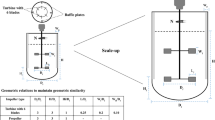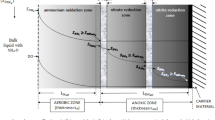Abstract
A horizontal rotating tubular bioreactor (HRTB) is a plug flow bioreactor whose interior is provided with O-ring-shaped partition walls that serve as carriers for microbial biomass. During this investigation, microbial biomass was grown in suspension and on the bioreactor inner surface as a microbial biofilm with average mass that was considerably higher than suspended biomass. The dynamics of bioprocess in HRTB was studied by different combinations of process parameters (bioreactor rotation speed and mean residence time) and it was monitored by withdrawing the samples from five positions along the bioreactor. During this investigation it was also observed that mean residence time had a more pronounced effect on the bioprocess dynamics than bioreactor rotation speed. For the description of bioprocess kinetics in HRTB an unstructured kinetic model was established that defines biomass growth, product formations and substrate consumption rate by using a modified Monod (Levenspiel) model. This kinetic model defines changes in suspension and in microbial biofilm, and it shows relatively good agreement with experimental data.






Similar content being viewed by others
Abbreviations
- f :
-
Ratio between volume of biofilm and liquid in HRTB (m3 m−3)
- K S :
-
Substrate saturation constant (kg m−3)
- K SM2 :
-
Substrate saturation constant for biofim maintenance (kg m−3)
- K SP1 :
-
Substrate saturation constant for ethanol production in biofilm (kg m−3)
- K SP2 :
-
Substrate saturation constant for lactate production in biofilm (kg m−3)
- L :
-
Bioreactor length (m)
- m 2 :
-
Specific maintenance rate of biofilm (kg kg−1 h−1)
- m 2max :
-
Maximal specific maintenance rate of biofilm (kg kg−1 h−1)
- n :
-
Bioreactor rotation speed (s−1)
- P 1 :
-
Ethanol concentration (kg m−3)
- P 1*:
-
Critical ethanol concentration (kg m−3)
- P 1,0 :
-
Initial ethanol concentration (kg m−3)
- P 2 :
-
Lactate concentration (kg m−3)
- P 2,0 :
-
Initial lactate concentration (kg m−3)
- q P1 :
-
Specific rate of ethanol production in suspension (kg kg−1 h−1)
- q P1max :
-
Maximal specific rate of ethanol production in suspension (kg kg−1 h−1)
- q P1,2 :
-
Specific rate of ethanol production in biofilm (kg kg−1 h−1)
- q P1,2max :
-
Maximal specific rate of ethanol production in biofilm (kg kg−1 h−1)
- q P2,2 :
-
Specific rate of lactate production in biofilm (kg kg−1 h−1)
- q P2,2max :
-
Maximal specific rate of lactate production in biofilm (kg kg−1 h−1)
- S :
-
Substrate concentration (kg m−3)
- S 0 :
-
Initial substrate concentration in medium inflow (kg m−3)
- w :
-
Mean liquid flow velocity (m s−1)
- X 1 :
-
Biomass concentration in suspension (kg m−3)
- X 2A :
-
Average areal density of biofilm (kg m−2)
- X 2V :
-
Average volumetric density of biofilm (X 2A /δ) (kg m−3)
- X 2 :
-
Biofilm volumetric density recalculated on the volume of suspension in HRTB [X 2V f; Eqs. 3, 4, 5] (kg m−3)
- Y P1/S :
-
Ethanol conversion coefficient (kg kg−1)
- Y P2/S :
-
Lactate conversion coefficient (kg kg−1)
- Y X1/S :
-
Biomass conversion coefficient (kg kg−1)
- δ :
-
Average biofilm thickness (m)
- μ :
-
Specific growth rate (s−1)
- μ max :
-
Maximal specific growth rate (s−1)
- τ :
-
Mean residence time (s)
References
Moser A (1985) Imperfectly mixed bioreactor systems. In: Moo-Young M (ed) Comprehensive biotechnology, vol 2. Pergamon Press, Oxford, pp 77–98
Wolfbauer O, Klettner H, Moser F (1978) Reaction engineering models of biological waste water treatment and kinetics of activated sludge process. Chem Eng Sci 33:953–960
Bishop PL, Kinner NE (1986) Aerobic fixed—film process. In: Rehm HJ, Reed G (eds) Biotechnology, vol 8. VCH Verlagsgesellschaft, Weinheim, pp 113–176
Wu CY, Smits ED, Huang TY (1980) Modelling of rotating biological contactor systems. Biotechnol Bioeng 22:2055–2064
Radwan KH, Ramanujam TK (1997) Studies on organic removal of 2,4-dichlorophenol in wastewaters using a modified RBC. Bioprocess Eng 16:219–223
Swaminathan G, Ramanujam TK (1999) Effect of substrate concentration on biodegradation of 2,4-dichlorophenol using modified rotating biological contactors. Bioprocess Eng 21:169–173
Kornegay BH, Andrews JF (1968) Kinetics of fixed film biological reactors. J Water Pollut Control Fed 40:460–467
Andrews GF (1991) Aerobic wastewater process models. In Rehm HJ, Reed G, Pühler A, Stadler P (eds) Biotechnology, vol 4. VCH Verlagsgesellschaft, Weinheim, pp 409–437
Converti A, Del Borghi A, Zilli M, Arni S, Del Borghi M (1999) Anaerobic digestion of the vegetable fraction of municipal refuses: mesophilic verses thermophilic conditions. Bioprocess Eng 21:371–376
Benitez FJ, Beltran-Heredia J, Torregrosa J, Acero JL (1997) Improvement of the anaerobic digestion of olive mill wastewaters by prior ozonation pretretment. Acta Biotechnol 17:169–175
Levenspiel O (1980) The Monod equation: a revisit and a generalisation to product inhibition situations. Biotechnol Bioeng 22:1671–1687
Han K, Levenspiel O (1988) Extended Monod kinetics for substrate, product and cell inhibition. Biotechnol Bioeng 32:430–437
Andrews JF (1968) Modelling of biological treatment process. Biotechnol Bioeng 10:707–723
Lewandowski Z (1985) Denitrification in packed bed reactors presence of chromium (VI). Wat Res 21:147–153
Gaudy AF, Ekambaram A, Rozich AF (1988) Practical methodology for predicting critical operation range of biological systems treating inhibitory substances. J Water Pollut Control Fed 60:77–85
Brown SC, Grady CPL, Tabak HH (1990) Biodegradation and kinetics of substituted phenols. Water Res 24:853–861
Sathish N, Young JC, Tabak HH (1993) Protocol for determining the rate of biodegradation of toxic organic chemicals in anaerobic processes. In: Tedder DW, Pohland FG (eds) Emerging technologies in hazardous waste management III. ACS Symp Ser 518, Am Chem Soc, Washington DC, pp 203–218
Gavrilescu M (2002) Engineering concerns and new developments in anaerobic wastewater treatment. Clean Technol Environ Policy 3:346–362
Ohara H, Hiyama K, Yoshida T (1992) Non-competitive product inhibition in lactic acid fermentation from glucose. Appl Microbiol Biotechnol 36:773–776
Silva EM, Yang ST (1995) Kinetics and stability of fibrous bed bioreactor for continuous production of lactic acid from unsupplemented acid whey. J Biotechnol 41:59–70
Moser A (1988) Bioprocess technology—kinetics and reactors. Springer, Berlin Heidelberg New York
Borchardt JA (1971) Biological waste treatment using rotating discs. Biotechnol Bioeng Symp 2:131–140
Šantek B, Horvat P, Novak S, Mayr B, Moser A, Marić V (1996) Mathematical model of mixing in a horizontal rotating tubular bioreactor: “Simple flow” model. Bioprocess Eng 14:195–204
Šantek B, Horvat P, Novak S, Mayr B, Moser A, Marić V (1996) Mathematical model of mixing in a horizontal rotating tubular bioreactor: “Spiral flow” model. Bioprocess Eng 14:223–229
Šantek B, Horvat P, Novak S, Moser A, Marić V (1998) Studies on mixing in horizontal rotating tubular bioreactor: Part I Optimisation of adjustable parameters for “spiral flow” model. Bioprocess Eng 18:467–473
Šantek B, Horvat P, Novak S, Sunko D, Moser A, Marić V (2000) Estimation of axial dispersion in horizontal rotating tubular bioreactor by means of a structured model. Bioprocess Eng 23:265–274
Šantek B, Horvat P, Novak S, Moser A, Marić V (1998) Studies on mixing in horizontal rotating tubular bioreactor: Part II Prediction systems for adjustable parameters of “spiral flow” model. Bioprocess Eng 19:19–28
Šantek B, Horvat P, Novak S, Moser A, Marić V (1998) Studies on mixing in horizontal rotating tubular bioreactor: Part III Influence of liquid level and distance between the partition walls on prediction systems for adjustable model parameters. Bioprocess Eng 19:91–102
Peyton BM (1996) Effects of shear stress and substrate loading rate on Pseudomonas aeruginosa biofilm thickness and density. Water Res 30:29–36
Gavrilescu M, Macoveanu M (2000) Attached-growth process engineering in wastewater treatment. Bioprocess Eng 23:95–106
Burden R, Faires JD (1988) Numerical analysis. PWS-KENT, Boston
Branch MA, Grace A (1996) Matlab optimisation toolbox user’s guide. MathWorks Inc, Natick, USA
Käppeli O (1986) Regulation of carbon mechanism in Saccharomyces cerevisiae and related yeasts. Adv Microb Physiol 28:181–209
Moser A (1991) Tubular bioreactor: case study of bioreactor performance for industrial production and scientific research. Biotechnol Bioeng 37:1054–1065
Lu ZX, Fujimura T (1993) A study on ethanol production of yeast cells immobilized with polymer carrier produced by radiation polymerization. Radiat Phys Chem 42:923–926
Venkataraman R, Ramanujam TK (1998) A study of microbiology of biological film layer in rotating biological contactors. Bioprocess Eng 18:181–186
Pirt SJ (1975) Principles of microbe and cell cultivation. Blackwell Scientific, Oxford
Ogawa M, Shimizu K, Nomoto K, Tanaka R, Hamabata T, Yamasaki S, Takeda T, Takeda Y (2001) Inhibition of in vitro growth of Shiga toxin-producing Escherichia coli O 157:H7 by probiotic Lactobacillus strains due to production of lactic acid. Int J Food Microb 68:135–140
Narendranath NV, Thomas KC, Ingledew WM (2001) Acetic and lactic acid inhibition of growth of Saccharomyces cerevisiae by different mechanisms. J Am Soc Brew Chem 59:187–194
Moser A (1985) Reaction and mass transfer interactions in microbial systems. In: Rehm HJ, Reed G (eds) Biotechnology, vol 2. VCH Verlagsgesellschaft, Weinheim, pp 195–305
van Hoek P, van Dijken JP, Prock JT (1998) Effect of specific growth rate on fermentative capacity of baker’s yeast. Appl Environ Microbiol 64:4226–4233
Stewart PS (1993) A model of biofilm detachment. Biotechnol Bioeng 41:111–117
Peyton BM, Characklis WG (1993) A statistical analysis of the effect of substrate utilisation and shear stress on the kinetics of biofilm detachment. Biotechnol Bioeng 41:728–735
Author information
Authors and Affiliations
Corresponding author
Rights and permissions
About this article
Cite this article
Ivančić, M., Šantek, B., Novak, S. et al. Bioprocess kinetics in a horizontal rotating tubular bioreactor. Bioprocess Biosyst Eng 26, 169–175 (2004). https://doi.org/10.1007/s00449-003-0346-9
Received:
Accepted:
Published:
Issue Date:
DOI: https://doi.org/10.1007/s00449-003-0346-9




